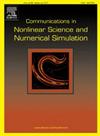Stochastic stability of nonlinear mechanical metamaterial systems under combined Gaussian and Poisson white noises
IF 3.4
2区 数学
Q1 MATHEMATICS, APPLIED
Communications in Nonlinear Science and Numerical Simulation
Pub Date : 2025-01-18
DOI:10.1016/j.cnsns.2025.108621
引用次数: 0
Abstract
Mechanical metamaterials are a class of artificially designed structures usually modeled as high degree-of-freedom (DOF) systems. They, particularly nonlinear mechanical metamaterials, are widely applied in vibration suppression. This manuscript proposes a method to study the stochastic stability of nonlinear mechanical metamaterial systems under combined Gaussian and Poisson white noises. The mathematical model of a nonlinear mechanical metamaterial with coupled elements is established, and its governing equation, which is a high-DOF nonlinear stochastic differential equation, is derived. To bypass the challenge of calculating multiple Lyapunov exponents, the governing equation is reduced as a one-dimensional averaged stochastic differential equation by applying the stochastic averaging method. The specific expression of the Lyapunov exponent of the one-dimensional equation is derived by using the two-step generalized elliptic coordinate transformations, and its sign yields the necessary and sufficient condition of stochastic stability. A nonlinear mechanical metamaterial with 10 coupled elements is taken as an example to illustrate the effectiveness of the proposed procedure and to investigate the effect of system parameters on the stochastic stability of nonlinear mechanical metamaterials.
高斯白噪声和泊松白噪声联合作用下非线性机械超材料系统的随机稳定性
机械超材料是一类人工设计的结构,通常建模为高自由度系统。它们,特别是非线性机械超材料,在振动抑制中有着广泛的应用。本文提出了一种研究高斯白噪声和泊松白噪声联合作用下非线性机械超材料系统随机稳定性的方法。建立了具有n个耦合单元的非线性力学超材料的数学模型,推导了其控制方程为高自由度非线性随机微分方程。为了避免计算多个李雅普诺夫指数的困难,采用随机平均法将控制方程简化为一维平均随机微分方程。利用两步广义椭圆坐标变换,导出了一维方程Lyapunov指数的具体表达式,其符号给出了随机稳定性的充分必要条件。以一个10元耦合的非线性机械超材料为例,说明了所提方法的有效性,并探讨了系统参数对非线性机械超材料随机稳定性的影响。
本文章由计算机程序翻译,如有差异,请以英文原文为准。
求助全文
约1分钟内获得全文
求助全文
来源期刊

Communications in Nonlinear Science and Numerical Simulation
MATHEMATICS, APPLIED-MATHEMATICS, INTERDISCIPLINARY APPLICATIONS
CiteScore
6.80
自引率
7.70%
发文量
378
审稿时长
78 days
期刊介绍:
The journal publishes original research findings on experimental observation, mathematical modeling, theoretical analysis and numerical simulation, for more accurate description, better prediction or novel application, of nonlinear phenomena in science and engineering. It offers a venue for researchers to make rapid exchange of ideas and techniques in nonlinear science and complexity.
The submission of manuscripts with cross-disciplinary approaches in nonlinear science and complexity is particularly encouraged.
Topics of interest:
Nonlinear differential or delay equations, Lie group analysis and asymptotic methods, Discontinuous systems, Fractals, Fractional calculus and dynamics, Nonlinear effects in quantum mechanics, Nonlinear stochastic processes, Experimental nonlinear science, Time-series and signal analysis, Computational methods and simulations in nonlinear science and engineering, Control of dynamical systems, Synchronization, Lyapunov analysis, High-dimensional chaos and turbulence, Chaos in Hamiltonian systems, Integrable systems and solitons, Collective behavior in many-body systems, Biological physics and networks, Nonlinear mechanical systems, Complex systems and complexity.
No length limitation for contributions is set, but only concisely written manuscripts are published. Brief papers are published on the basis of Rapid Communications. Discussions of previously published papers are welcome.
 求助内容:
求助内容: 应助结果提醒方式:
应助结果提醒方式:


